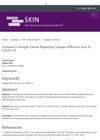Search
for
Sort by
Research
840-870 / 1000+ results
research Clinical Efficacy of Catgut Embedment Combined with Moxibustion and Bloodletting in the Treatment of Androgenic Alopecia
Traditional Chinese medicine techniques like catgut embedment, moxibustion, and bloodletting showed better results for treating hair loss than the drug finasteride.

research Evaluation of Serum G Protein-Coupled Estrogen Receptor 1 (GPER-1) Levels in Patients with Androgenetic Alopecia
Alopecia patients have less GPER-1, which might affect hair loss.

research Real-World Experience and Long-Term Evaluation of Tofacitinib in Refractory Alopecia Areata: A Prospective, Open-Label, Single-Center Study in Asian Arab Population
Tofacitinib is a promising treatment for severe alopecia areata, with many patients experiencing complete or partial hair regrowth.

research Exosomes Secreted from Adipose-Derived Stem Cells Are a Potential Treatment Agent for Immune-Mediated Alopecia
Exosomes from fat-derived stem cells can potentially improve hair growth and could be a new treatment for immune-related hair loss.
research Combination Therapy with Platelet-Rich Plasma and Minoxidil Leads to Better Clinical Results Than Monotherapy in Men with Androgenetic Alopecia
Using both PRP and minoxidil together works better for treating hair loss in men than using either one alone.

research Cicatricial Marginal Alopecia: Is It All Traction?
Traction may not be the only cause of cicatricial marginal alopecia.

research Transverse Sections for Diagnosis of Alopecia?
Vertical sections are better than horizontal sections for diagnosing alopecia.

research Growth Hormone-Responsive Alopecia in Dogs
The exact cause of growth hormone-responsive alopecia in dogs is unclear.

research Follicular Red Dots: A Normal Trichoscopy Feature in Patients with Pigmentary Disorders?
Follicular red dots may be a normal feature seen in people with less skin pigmentation, not necessarily indicating a scalp disorder.

research Efficacy of Diphenylcyclopropenone in Alopecia Areata: A Comparison of Two Treatment Regimens
Treating alopecia areata every 3 weeks with diphenylcyclopropenone is more effective than weekly treatments.

research Trichoscopic Findings of Trichotillomania: New Observations
Trichoscopy is useful for diagnosing hair-pulling disorder.
research A Folliculocentric Perspective of Dandruff Pathogenesis: Could a Troublesome Condition Be Caused by Changes to a Natural Secretory Mechanism?
Dandruff might be caused by changes in how hair follicles naturally release oils and an immune response to this imbalance.
research Trichoscopic Findings in Androgenetic Alopecia
Trichoscopy, a hair loss evaluation technique, found that people with Androgenetic Alopecia have more thin hairs, yellow dots, and perifollicular discoloration than healthy individuals.
research Value of Dermoscopy for the Diagnosis of Monilethrix
Dermoscopy helped diagnose a rare hair disorder in a 2-year-old boy.

research Increase in Google Trends Regarding Telogen Effluvium Due to COVID-19
Public interest in hair loss increased during the COVID-19 pandemic.
research Visual Field Defect in a Patient Given Sodium Valproate Then Carbamazepine: Possible Effect of Aminotransferase Inhibition
Anti-epileptic drugs may cause visual and hair side effects due to enzyme inhibition, especially in genetically predisposed individuals.

research Homocysteine in Androgenetic Alopecia: A Case Control Study and Observational Experiments on Mice
Higher homocysteine levels may inhibit hair growth and are linked to androgenetic alopecia.

research Androgenetic Alopecia: A Review
Androgenetic alopecia is a common hair loss condition influenced by various factors and linked to psychosocial and cardiovascular issues.

research Study on Kesha Shareera with Special Reference to Male Pattern Baldness in Relation to Daihika Prakruti
Certain Prakruti types are more prone to early male pattern baldness.

research Nitric Oxide Synergizes Minoxidil Delivered by Transdermal Hyaluronic Acid Liposomes for Multimodal Androgenetic Alopecia Therapy
The new hair loss treatment combining nitric oxide and minoxidil in a special carrier is effective for hair regrowth.

research Non-Invasive Techniques for Evaluating Alopecia Areata
Non-invasive methods can effectively diagnose and manage alopecia areata.

research Psychological Aspect of Alopecia
Hair loss can significantly impact a person's mental health, causing issues like anxiety and depression, and stress can trigger hair loss.
research Loose Anagen Syndrome in One Identical Twin Girl
One twin girl has Loose anagen syndrome with poorly anchored hair, diagnosed with a simple hair pull test, while her identical twin does not have the condition.

research Hyperactivation of Sympathetic Nerves Drives Depletion of Melanocyte Stem Cells
Stress causes hair graying by overactivating nerves that deplete color-giving stem cells.

research Investigator-Blinded, Controlled, and Randomized Comparative Study on 1565 Nm Non-Ablative Fractional Laser Versus 5% Minoxidil for Treatment of Androgenetic Alopecia
The 1565 nm non-ablative fractional laser is more effective and satisfying than 5% minoxidil for treating hair loss.

research Post-Discharge Persistent Symptoms and Health-Related Quality of Life After Hospitalization for COVID-19
Many COVID-19 survivors experience long-term symptoms but still report satisfactory quality of life and return to work.

research Severe Acute Respiratory Syndrome Among Children
Children, especially teenagers, can get severe SARS-CoV infection with symptoms similar to adults, but they typically recover well with supportive care.

research Keratin Disorders: From Gene to Therapy
New treatments targeting specific genes show promise for treating keratin disorders.

research Enhancing the Growth of Natural Eyelashes: The Mechanism of Bimatoprost-Induced Eyelash Growth
Bimatoprost is a safe and effective treatment for making eyelashes longer, thicker, and darker.